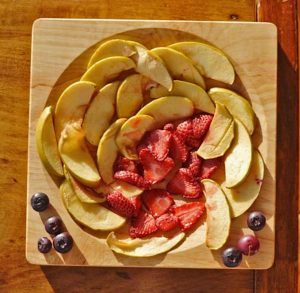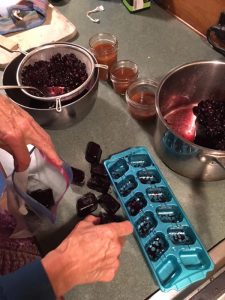The wild fruits of the Vineyard offer themselves free of charge to us humans, the birds, the deer, and all the other fruit-loving critters. Along the sides of the roads and paths, the edges of fields, and near the shore, you can find fruit ripening now. Sometimes it’s the fruit you find fallen onto the path or road that helps you locate an apple or chokecherry tree. Along the edges of the beaches and bluffs, the red rose hips of the rosa rugosa are ripe. Beach plum bushes often grow near them. The grapes are plentiful under the leaves of draping vines in sunny places. Autumn olive berries, the fruit of the silver-green leafed invasive elaeagnus umbellata that grows in just about any open area, is ripening now and into the fall. The berries turn red and juicy and, eventually, sweet or tart, depending on the bush. There are many traditional ways to use the island’s fruit bounty, but it’s fun to experiment, too.
Jelly, jam, or fruit butter can be made out of any of the fruits. You can simmer the freshly picked fruit with a little water, more or less depending on how tender the fruit is and how strong you want the finished juice to be. Mash the fruit as it cooks, and then put it through a strainer or food mill in order to separate out the pits, seeds, and skin. If you want a clear juice for jelly, let the cooked fruit drip through a fine sieve or cheesecloth. With autumn olives, use a small amount of water, mash the fruit, and heat it without boiling, or you may end up with gray juice and a separate bright red pulp. They taste just as good, but don’t look as appetizing.

A crockpot is handy for cooking down any fruit pulp to a fruit butter consistency — thick and glistening. You can add a sweetener and some cinnamon early on, or just use plain fruit, and cook it on low with the top off, stirring occasionally. There are all kinds of jam and jelly recipes on the Pomona’s Pectin box, using different sweeteners, and even a recipe for a no-cook jam.
Another easy way to preserve fruit is to make juice and freeze it in ice cube trays, then pop the cubes out and store them in the freezer in bags or jars. The cubes are good for flavoring plain or fizzy water, or adding to smoothies throughout the winter. Apple, chokecherry, grape, and beach plum cubes are particularly good in fizzy water. For smoothies, you can freeze the pulp as well as the juice of any fruit. They’re good for flavoring yogurt, too.
You can dry cut-up fruit in the sun or with a dehydrator, or the oven set on a very low temperature. I make apple rings from the better apples, hanging them from a string in my greenhouse, and dry pieces cut from the wormy apples in a dehydrator. You can pit beach plums by hand (kind of tedious, but worth it) and add the dehydrated plums to granola or trail mix.
Another way to dry fruit is to make fruit leather, either in a dehydrator or a low-temperature oven. Apples, grapes, rose hips, and autumn olives make very tasty fruit leathers. Dehydrators come with a fruit-roll sheet accessory, or you can use parchment paper, or for the oven, a glass pan greased with coconut oil. Use the fruit purée after putting the cooked pulp through a sieve (no need to sweeten it); pour out a thin layer and let it dry at about 135º for 12 to 24 hours until there are no wet areas. Store cut-up leather pieces in a tight container indefinitely.
Any fruit can be frozen in Ziplock bags or jars for future smoothies, fruit crisps, or sauces. I freeze uncooked grapes and autumn olives whole for smoothies. Pitted beach plums and apple pieces can be frozen for future smoothies and fruit crisps. A fruit crisp is a delicious way to use any fruit. If you don’t have enough of one kind of fruit, you can experiment with mixing different ones. My favorite topping for crisps is this: a cup of rolled oats, a cup or less of flour, a stick of butter, some cinnamon, coriander, and a pinch of cardamom, and a little sweetener — either coconut palm sugar (low on the glycemic index) or maple syrup — mixed with fingers to a crumbly texture, spread on top of the cut-up fruit in a shallow pan and baked at 375º until the top is brown and the fruit is bubbling.

One of my new favorite fruit recipes this summer is from Linsey Lee’s book “Edible Wild Plants of Martha’s Vineyard,” first published in 1975. The “Scandinavian Chokecherry Soup” recipe came from West Tisbury’s Sophie Block, and it calls for juice extracted from the fruit and mixed with an equal amount of water. Bring this to a boil and simmer with the juice and rind of a lemon and a stick of cinnamon for about 20 minutes. Strain the mixture and add sweetener to taste. When it’s cooled a little, thicken it with cornstarch or arrowroot (a tablespoon or two mixed in cold water first), heating the mixture just until it becomes clear. Serve it hot or cold with a dollop of sour cream or yogurt. The wild, sweet taste of this soup nearly makes me swoon. I’ve tried this soup with beach plum juice, and it’s just as amazing. I’m also wondering about making this soup with dumplings, adding the batter by the spoonful and simmering it for about 20 minutes until the dumplings are cooked. The flour from the dumplings would probably thicken the soup without any added cornstarch.
The taste of rosehip purée (simmered rose hips put through a food mill) mixed with lemon juice and honey is one of my favorite wild flavors. I’ve used this to make jam, fruit butter, and fruit crisps, and as topping for pancakes and yogurt. This summer I adapted a lemon square recipe to make a batch of mouthwatering rose hip squares. I used a basic shortbread recipe for the bottom (butter, flour, sugar) and baked that separately. After it cooled, I spread it with a rose hip topping made from rose hip purée, lemon juice and zest, and honey, thickened with arrowroot. If you pour the slightly cooled topping onto the shortbread, it gels nicely there.
Even if you find just a small amount of fruit, you can experiment by cooking it until it’s soft, straining it through a sieve, sweetening it if you like, and topping your yogurt or cooked cereal, adding it to a chutney, salsa, or salad dressing. You can add it to fizzy water, or just drink it right down, and enjoy the sweet taste of fall on the Vineyard.
This story by Margaret Knight originally appeared at mvtimes.com
